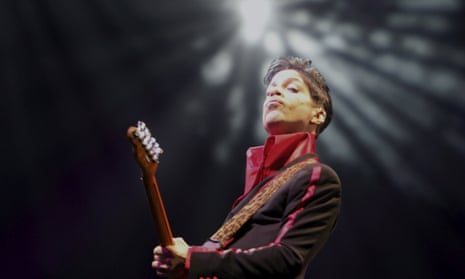Prince’s death at the age of 57, a year ago today, was not artfully stage-managed like David Bowie’s. There was no elegant album release to act as the final wave goodbye at the end of a glorious career. Twelve months on, the reasons for Prince’s death, the fate of his estate and the likelihood of us hearing the full contents of his fabled vault remain unclear. We have, however, learned quite a lot about the purple one’s cycling habits, his smartphone aversion and his unlikely property empire. Things like…
Prince had a drug problem, though not in the way you might think. Prince became a Jehovah’s Witness in 2001, and was remarkably clean-living. You were not permitted to drink or smoke at his Paisley Park shows, and musicians had to pay into a “cuss bucket” if they used foul language. However, Prince did suffer from hip problems, some say as a result of his stage routine. Sheila E recalled how, on the 1984-85 Purple Rain tour, Prince “was in pain all the time”, but kept jumping off stage risers while wearing stack heels. A 2008 New Yorker profile described Prince as “limping slightly”, and in 2009 he was rumoured to have turned down a double hip replacement, as Jehovah’s Witnesses may not receive blood transfusions. It’s unclear whether he eventually went through with the operation, though he appears to have begun taking opioids to control his pain. His ex-wife, Mayte Garcia, also suggests the death of his infant son, Boy Gregory, drove him towards pills.
Days before his death, Prince’s staff had contacted Dr Howard Kornfeld, a Californian specialist in pain-medication addiction. Kornfeld was unable to see Prince personally, but sent his son, Andrew, in his place. Andrew was among Prince’s retinue when they discovered his body in a lift at Paisley Park, and it’s his voice audible on the 911 call recording.

Nobody is really sure how he got the drugs that killed him. Doctors ruled that Prince died from an accidental overdose of fentanyl, a synthetic painkiller about 50 times stronger than heroin. Over the past year many of his friends and colleagues admitted the singer had a prescription drug problem. However, investigators were unable to track down any prescriptions made out for Prince.
His bodyguard Kirk Johnson appears to have been prescribed another opioid, oxycodone, on Prince’s behalf. Investigators also found numerous painkilling pills, including some that tested positive for fentanyl, at the singer’s home, though they have yet to conclude how he came by the drugs that led to his death. Local police say fentanyl was rarely found on the black market in Minneapolis, though illegally produced fentanyl, manufactured in Asia and packaged to look like prescription opioids, has been seized in the US.
Prince didn’t have a smartphone, and may have been a victim of phone hacking. As part of the investigations into his death, police sought to search Prince’s mobile phone records. However, according to a warrant application issued to Google, Prince had stopped carrying a phone since he believed his phone had been hacked. Instead, he preferred to communicate via email and landlines.
He had a pretty cool pseudonym. Police looking into the star’s death came across a briefcase belonging to a “Peter Bravestrong”, which they now believe was Prince’s assumed name when travelling. They also requested access to three associated emails: peterbravestrong@gmail.com, mistag3@gmail.com and paisleyparkafterdark@gmail.com.
Nobody has found Prince’s will and nobody really knows how much his estate is worth. A local judge has ruled that Prince died intestate, which means the star’s younger sister, Tyka Nelson, may inherit much of his wealth, alongside his five half-siblings. According to probate court records, Prince owned around $25m (£19.5m) in real estate, including, among other items, the detached suburban house featured in the Purple Rain video; as well as 67 10-ounce gold bars worth a little under $840,000, 10 cars, three motorbikes, $110,000 in four bank accounts and a tour bus. However, administrators are finding it harder to place a figure on his intangible assets, such as copyrights to unreleased music, or name and likeness rights. Current estimates run between $200-300m.

Despite the judge’s ruling, Garcia believes the star did draw up a will, but may have destroyed it. Meanwhile, plenty of less credible claimants have come forward, including one woman who says the CIA covered up her marriage to the singer.
Prince’s ashes are stored in an urn made by the same company that made Lemmy’s. The star was cremated following a low-key ceremony costing just $1,645, but his final resting place is a little more snazzy. His family commissioned the celebrity urn manufacturers Foreverence to create an urn in the shape of Paisley Park. This 3D-printed, 14in x 14in crystal-encrusted box currently forms part of the Paisley Park tour; Prince’s ashes are sealed in the model’s front column.
Though the urn is among Foreverence’s more notable creations, it is not the first time the firm has worked for the stars. It also supplied bespoke urns for Motörhead’s Lemmy, Stone Temple Pilots’ Scott Weiland and Devo’s Bob Casale.
There is more music coming … Warner Bros renewed its contact with Prince in 2014, and plans to release a remastered version of Purple Rain, as well as two discs of new music and two complete concert films, on 9 June. Some of these recordings will be new versions of old tunes but others, including the Purple Rain outtake, Electric Intercourse, and Father’s Song, which Prince wrote with his dad John Nelson, are unheard.
… though maybe not just yet. Lawyers acting on behalf of the artist have prevented George Ian Boxill, a sound engineer who once worked with Prince, from releasing a six-song EP featuring material recorded between 2006 and 2008. The collection, entitled Deliverance, has been pulled from iTunes and streaming services.
Even without this new material, Prince was the bestselling artist of 2016. According to Billboard, Prince sold 7.7m units last year, outstripping his closest rival, Adele, by more than 5m. His biggest sellers were The Very Best of Prince, Purple Rain and 1999.
Prince led a happier, more normal life than you might expect. Though he may have shunned publicity and cultivated an air of mystery, his final days appear to have been sunnier than we might imagine. The previous Saturday he had dropped into Electric Fetus, his local CD shop – it was Record Store Day – to buy albums by Stevie Wonder, Joni Mitchell and Santana, as well as discs by the 80s synth pop band Missing Persons, the gospel singers the Swan Silvertones, and the soul group the Chambers Brothers. Fans also managed to shoot mobile phone footage of him cycling around the car park of his local mall that weekend.
Meanwhile, the 32-year-old vocalist Judith Hill, perhaps Prince’s last protege, recalled how the singer loved animated movies such as Zootopia, often beat her at table tennis and could cook a mean omelette. Surely this is how we should remember him: as a half-decent chef and amateur cyclist, as well as perhaps the greatest pop star of the 20th century.

Comments (…)
Sign in or create your Guardian account to join the discussion